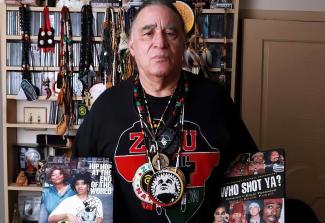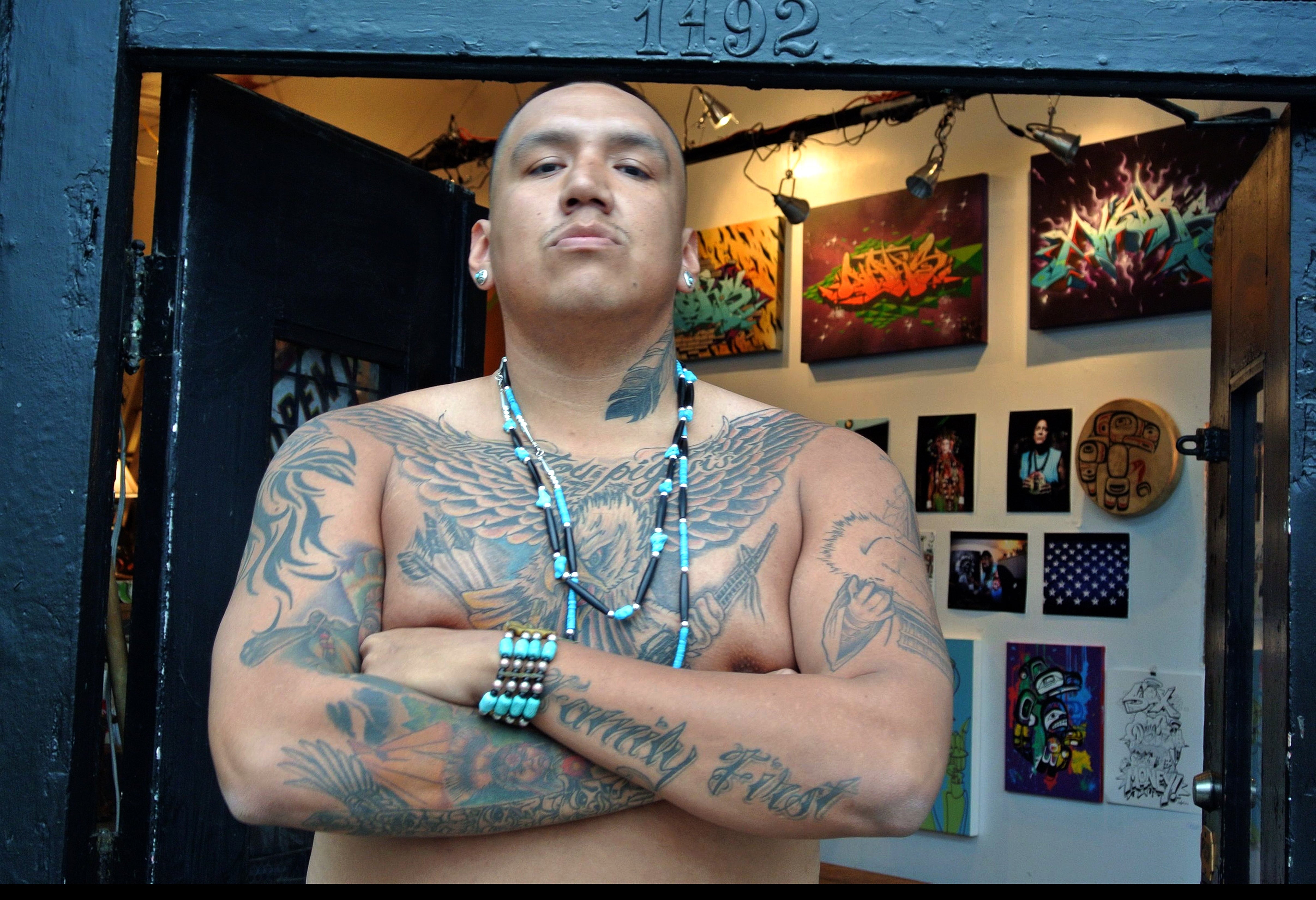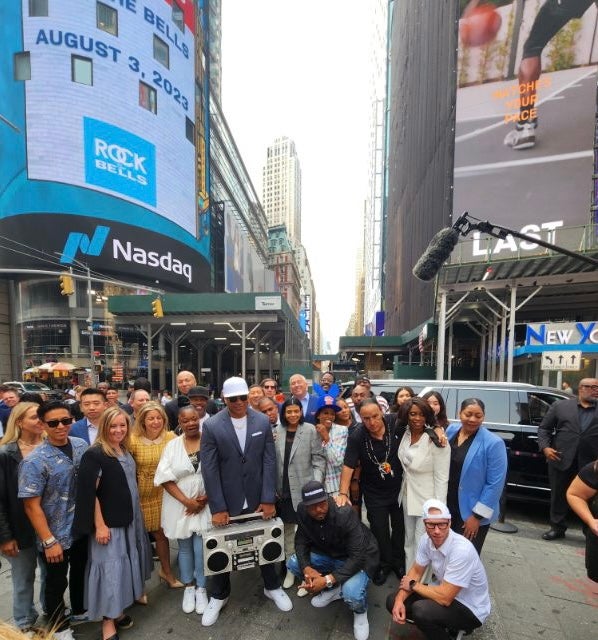
Hip-hop is celebrating its 50th anniversary this year, having emerged from Bronx streets in (more or less) 1973. As a social, cultural, and at times political movement, it has brought together the artforms of emceeing, deejaying, street dancing, and a distinct style of art as graffiti; a unique and revolutionary remix of sounds, styles, and voices indigenous to New York City, and yet actual Indigenous New Yorkers aren’t typically included in its origin stories—with one notable exception. A certain Cree has always been, per hip-hop vernacular, “in the place to be.”
Ernie Paniccioli has been as much part of the movement as a documenter of its history, among the first of its dedicated photographers from print magazine pages to album covers of some of its most significant performers. A 2014 Hip Hop Hall of Fame inductee, these days he lectures often about this legacy. His work features in galleries and museums internationally, and the Ernie Paniccioli Archive resides within Cornell University’s digital collections. At age 76, Brother Ernie (as he’s fondly known) has earned a true place of honor as a beloved community Elder. Cristina Verán spoke with him about this legacy.
CV: What was it like for you, growing up Native in New York City?
Ernie Paniccioli: I grew up in Brooklyn, a stereotypical melting pot of Italians, Black folks, Puerto Ricans . . . you name it. My Cree roots are from both sides of the U.S./ Canada border, but those links were broken when my single-parent mother went through the pain and hurt of the foster care system as a child. Like hers, my experience was removed from our Cree language and culture for the most part. While I had friends of every color, my biggest influences were from Brooklyn’s Mohawk community. They recognized me as being Native like them. When they first saw me on their block, without even asking my name, they just shouted, “Come play ball with us!”
I had this Italian surname, but didn’t have the face that was supposed to go with it. White kids used to call me Geronimo, and either be scared of me or want to fight me. One day five or six [kids] jumped me. Two brothers, Black kids, came to my rescue, and as I was lying there on the street, blood all over, they beat the crap out of my attackers. I looked up and asked, “Why’d you do that?” And they told me, “Cause you’re us!”
I didn’t understand at the time, but came to see that they just knew I wasn’t their enemy. They asked me to join their gang, The Bishops, and for a time I did. We were like a tribe. This bond we shared was a tribal thing—much like what I would eventually find in hip-hop. To me, hip-hop has an Indigenous vibe, with roots going back to African Indigenous Peoples.

Hip-hop artist Drezus (Anishinaabe and Plains Cree). Photo by Ernie Paniccioli.
CV: Describe some of your first encounters with hip-hop.
EP: I was in Jamaica back in 1967 and got to see up close the Jamaican DJ scene with its massive sound systems— what Kool Herc (widely credited as the Father of Hop-Hop) would begin to showcase at his parties in the Bronx during the early ‘70s, thus setting the stage for the culture’s birth. Eventually, here in New York City, what caught my attention was graffiti. The art was on the subways, in the streets, everywhere.
My (now ex-)wife got me a camera, and I would go out taking pictures of graffiti, documenting it. I tried to approach kids I’d see doing it, wanting to learn more about it, but they’d just run away from me. Then one day, this 5’3” Irish kid came up to me, looked me right in the eye, and said, “I ain’t scared of you!” They all thought I was a cop looking to bust them, so I had to explain who I was and what I was doing. Finally, he understood and invited me to go with them to an abandoned subway station at Worth Street, using a set of stolen keys to get in. What really blew me away when we got there was seeing a mural underground by the artist LEE.
After that, I started meeting others in the scene, deep thinkers who could see that hip-hop was a complex cultural thing bringing a rainbow of different communities together. I connected with members of the Zulu Nation (the pioneering collective with which most significant hip-hop artists at the time were affiliated), and I’d get invited to all these events where I just kept taking pictures. Among some of the more memorable figures for me was the graffiti artist VULCAN. His work was really visionary. I’d meet and shoot dance crews, too, like the New York City Breakers.
CV: Do you recall your first official hip-hop related photo assignment?
EP: The first rap group I was hired to shoot was Salt ‘N’ Pepa. I started out with the publications Right On and Black Beat, then joined Word Up Magazine and Rap Masters.
CV: You’re often referenced in regard to the album covers you’ve done for Public Enemy. How did that relationship come about?
EP: I used to get my slides processed at this lab in Manhattan, and the guy who did the work for me would play their music really loud. I liked it, and so I made a bunch of calls, trying to meet them. Finally I got a number, and Chuck D answered the phone. The rest is history. It’s been 30 years or so since then, and I’ve probably shot Public Enemy more than any other group. We became family. I’ve still got Chuck on speed dial.

Ernie Paniccioli with LL COOL J and his Rock The Bells team after they rang the Nasdaq opening bell on August 3, marking Hip-hop's 50th anniversary. Photo by Rodney Morris.
CV: How did you eventually link with specifically Indigenous hip-hop artists, who still often remain marginalized from the movement’s mainstream?
EP: I do want to point out that one of hip-hop’s pioneers, Melle Mel (of the Furious Five, with Grandmaster Flash) is actually Native—which most people don’t know—as his mom is Cherokee and his father is Black. There have also been [Indigenous identifying] Chicano artists like Kid Frost. But as far as those whose primary identity as performers intertwines with being Native, I had first met the rapper Shadowyze (Muscogee Creek) and then connected with Litefoot (Cherokee), who I featured in my book, “Who Shot Ya?” I was proud to introduce Litefoot on stage for a concert at Nassau Coliseum in New York back in 2004, for which he brought together Cherokee dancers, some Aztec dancers from Mexico, and Pop Master Fabel from the legendary Rock Steady Crew to perform on stage with him. Their performance was great but the overall experience was surreal, unfortunately not in a good way. Though some of the audience cheered, maybe half the crowd started booing, shouting anti-Native epithets at us before the performance even started. Litefoot represented to the max though, regardless; a brilliant man and beautiful brother.
CV: You’ve been spending a lot of time in Canada these days. How did that come about?
EP: I get invited to speak at hip-hop festivals, Indigenous events, museums, and such. And I’ve spent time in places like Six Nations, over in Edmonton, all across the country. I’ve worked with First Nations artists like Corey Bullpit, Creeasian, Dreezus . . . I love Dreezus, he’s like a brother.
CV: What’s next for you?
EP: I’m working on a series of 250 portraits for a book to be called “Stark: Kiss the Ring.” It will have a very limited print run; 100 copies at $1,000 each. My best work yet!
The Ernie Paniccioli Photo Archive: tinyurl.com/erniep.
--Cristina Verán is an international Indigenous Peoples-focused specialist researcher, strategist, curator, and mediamaker. As adjunct faculty at New York University's Clive Davis Institute of Recorded Music, she brings particular focus to Indigenous popular music and culture.
Top: Ernie Paniccioli holding his two books. Photo by Robert Adam Mayer/ PHOTOROBNYC.
